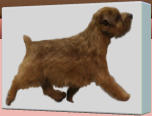

Breeders Corner

Kafka said, "All knowledge, the
totality of all questions and
answers, is contained in the dog."

Please submit your article,
publication or hyperlink to an
article to Judi Hartell.
DataDawg@Austin.rr.com
Submissions

Quote



The Bluebonnet Norfolk Terrier Club does not recommend,
guarantee, endorse, nor rate these recommendations or
contributors, their kennel or their stock. The purpose of this section
is to share the knowledge and experience of breeders who have vast
experience in whelping and raising puppies. The tips and tricks
below are intended to augment qualified veterinarian care, not as a
substitute for qualified veterinarian care of the dam and puppies.






Jerold S. Bell, D.V.M., clinical assistant professor of genetics at Tufts University School of
Veterinary Medicine, says that when there is no genetic test for carriers of an undesired
genetic trait, the most objective tool for selection against recessive disorders is a
relative-risk pedigree analysis
It is more difficult to predict affected and carrier dogs for some genetic disorders than
others. Polygenic traits, meaning two or more pairs of genes involved in heritability, can
be extremely challenging for scientists to develop a genetic test. Hip Dysplasia is an
example of a polygenic disease for which no genetic test has been developed. It is
easier to predict affected and carrier dogs for disorders having an autosomal recessive
mode of inheritance. In these cases, both parents of an affected dog are carriers, even
though they may appear normal. As the number of carriers increase, so will affected
dogs. Fortunately, it is possible to evaluate pedigrees for recessive trait risk and use this
information to make informed breeding decisions.
Relative-risk analysis does not identify carriers, just risk. Through pedigree analysis, you
can lower your chance of producing carriers with each generation, but you must limit
the number of breedable offspring, so as to not increase the carrier risk of the
population.
From www.PurinaProClub.com: Using Relative-Risk Pedigree Analysis in Breeding
Responsible breeders are selective about choosing the best dogs to breed. Beyond
considering physical characteristics, temperament and colors, breeders try to avoid
passing on genetic disorders. Unfortunately, breeders don’t always have the tools and
information necessary to make educated decisions.
It is more difficult to predict affected and carrier dogs for some genetic disorders than
others. Polygenic traits, meaning two or more pairs of genes involved in heritability, can
be extremely challenging for scientists to develop a genetic test. Hip Dysplasia is an
example of a polygenic disease for which no genetic test has been developed. It is easier
to predict affected and carrier dogs for disorders having an autosomal recessive mode
of inheritance. In these cases, both parents of an affected dog are carriers, even though
they may appear normal. As the number of carriers increase, so will affected dogs.
Fortunately, it is possible to evaluate pedigrees for recessive trait risk and use this
information to make informed breeding decisions.


- Behavior
- Honor Roll
- Living With Norfolk Terriers
- Fun With Your Norfolk
- Tip Of The Week
- Publications
- Therapy and Service Dogs
- Health & Nutrition
- Competition


- Books
- Clubs
- Collectibles, Gifts & Fun Activities
- Companion Animal Recovery
- Dog Show Superintendents
- Genetics
- Health Related Sites
- Canine Health Links
- Vaccination Protocols
- Animal Health Trust
- Online Mendelian Inheritance In Animals
- Univ. Of Cambridge Vet. School
- Canine Inherited Disorders Database
- All Creatures Veterinary Hospital
- A First Aid Kit
- Veterinary Pet Insurance
- AKC Pet Health Plan
- Cornell Univ. College of Vet. Medicine
- More Health Related Sites
- Independent Sites
- Pet Travel
- Training Your Puppy
- Publications


- Breeding Tips
- Breeding Tips Page One
- Breeding Tips Page Two
- Breeding Tips Page Three
- Breeding Tips Page Four
- Breeding Tips Page Five
- Breeding Tips Page Six
- Virus &The Pregnant Bitch
- Dog Neutering Video
- Vaccinations & The Pregnant Bitch
- Incontinence In The Pregnant Bitch
- Flagyl & The Pregnant Bitch
- Canine Reproduction
- Frozen vs Chilled Semen
- Modern Breeding Management
- Dialogue On Rasberry Leaves
- Monitoring Pregnancy
- Uses For Vaginal Cultures
- OFA & The Pregnant Bitch
- Breeding Tips Page Seven
- Breeding Tips Page Eight
- Breeding Tips Page Nine
- Breeding Tips Page Ten
- Breeding Tips Page Eleven
- Breeding Tips Page Twelve
- Breeding Tips Page Thirteen
- Breeding Tips Page Fourteen
- Genetics And Inheritance
- Rescue









